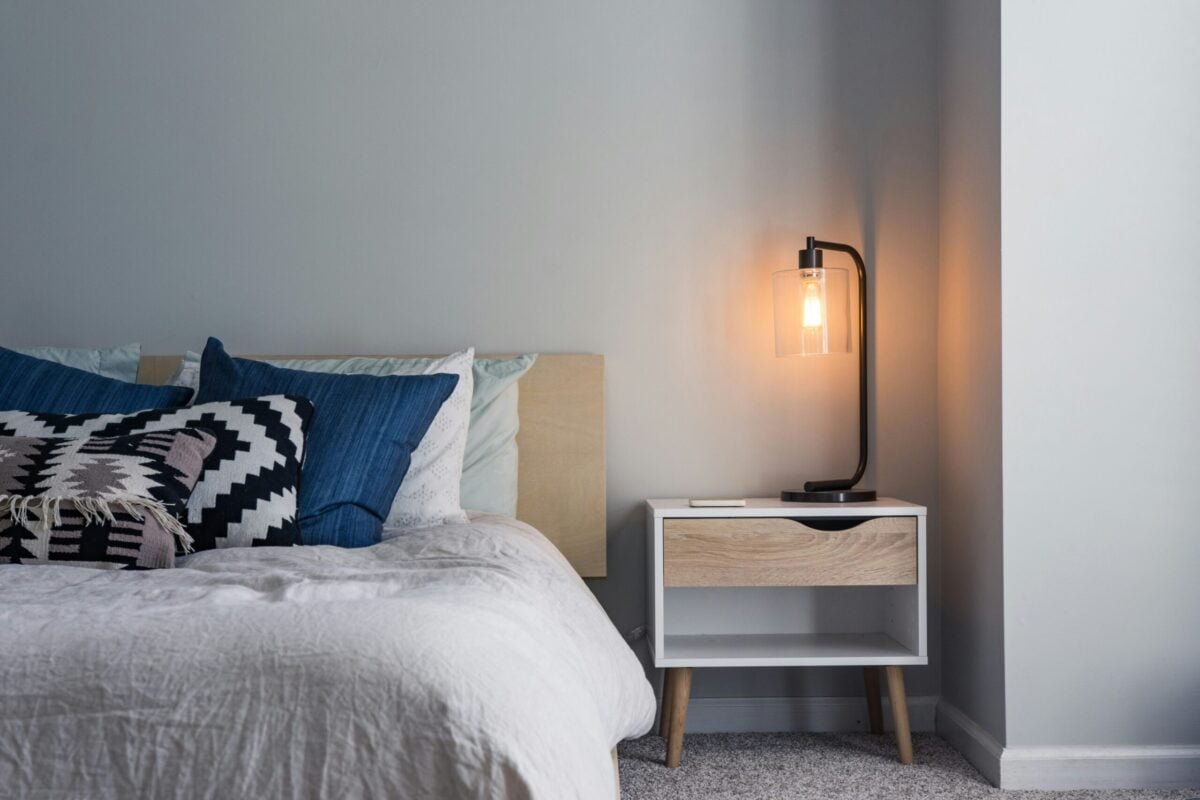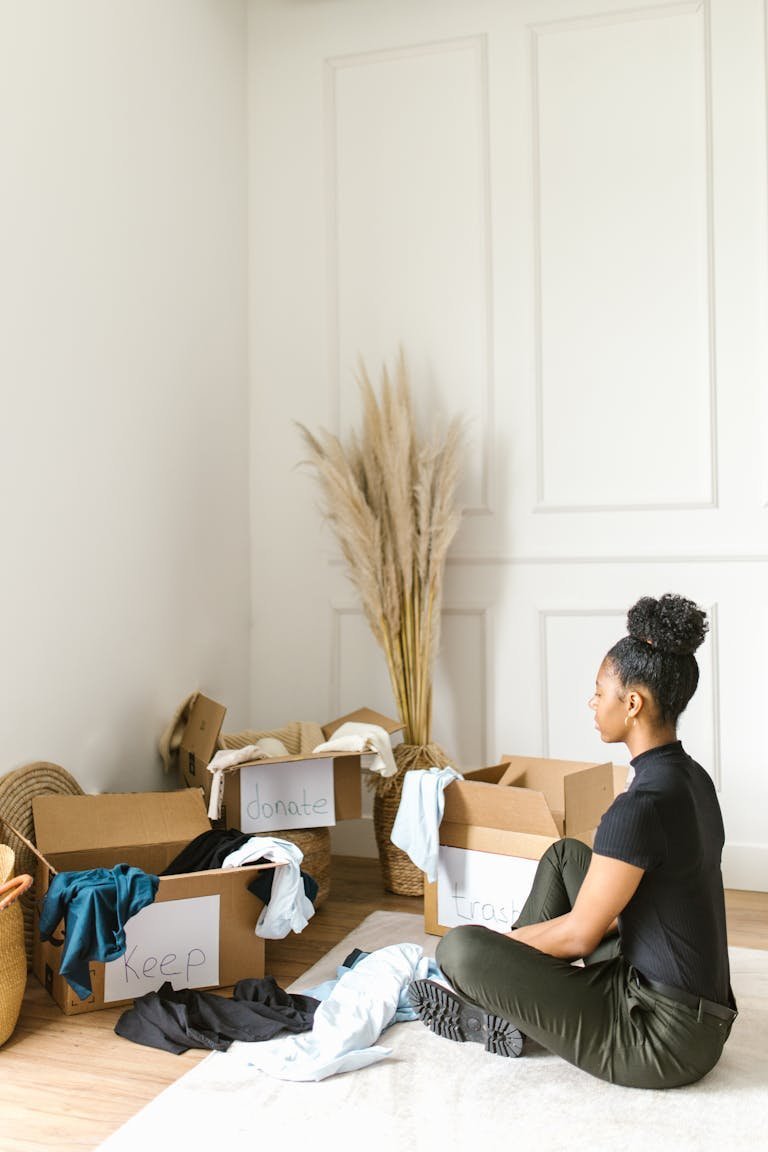11 Easy Steps to Declutter Your Bedroom
Many of us struggle with clutter in our bedrooms. What should be a peaceful retreat often becomes a catch-all for our belongings. If you’re feeling overwhelmed by the stuff accumulating in your space, you’re not alone. Let’s look at some practical ways to declutter your bedroom and create a more calming environment.
Why Decluttering Your Bedroom Matters
Before we get started, let’s talk about why a tidy bedroom is so crucial. Have you ever noticed how a messy room seems to cloud your mind? That’s not just your imagination! Clutter can significantly impact your sleep quality and stress levels. By creating a peaceful bedroom environment, you’re not just organising stuff – you’re investing in your mental health and productivity.
When heading to bed each evening you want to give your mind the sense that your life is in order, so that it can relax and let go. Sleep after all, really is our daily act of submission to our biology. A clutter-free sleeping space can work wonders for your overall well-being.
Now, let’s get to those 11 easy steps to declutter your bedroom:
Step 1: Set Clear Goals and Intentions

At the outset, take a moment to envision your ideal bedroom. What do you want to achieve?
- Better sleep?
- A calmer mind?
- More space?
We believe that an intention identified and articulated will give your brain’s problem-solving capacity a target to aim for. That means writing down your goals and keep them visible throughout the process. This will help you stay motivated when the going gets tough.
Step 2: Prepare for Your Decluttering Session
As with other decluttering tasks, it’s useful to gather what you before you get started. That will help avoid you getting distracted mid way through the process and losing momentum. You’ll want to arm yourself with your decluttering weapons – think boxes, bags, and labels. Our old favourite of KSDT (keep, sell, donate or trash) comes in handy but we’ll also be adding one more important category for the bedroom and that’s relocate (KDSTR). The bedroom is often the dumping ground for items as you start and end your day.
Now you’re armed with the tools, why not also put energising music to get you motivated for the task ahead.
Step 3: Start with a Clean Slate
Start by removing everything from your bedroom that doesn’t belong there. This is where the relocate stage comes in. Relocate those items to their proper homes in other parts of the house. If you’ve yet to designate a home for these items, take some time now to find one. When everything has a home it’s easy to tackle the clutter on a daily basis. Once items have been relocated to their appropriate homes, you can see your bedroom with fresh eyes and make the decluttering process less overwhelming.
Step 4: Clear Visible Surfaces
Now, let’s tackle the low-hanging fruit!
- Clear surfaces – like bedside tables/nightstands and dressers. No more “organised chaos”! Limit items to the essentials – a lamp, perhaps a book, and maybe a small dish for jewellery. Avoid cluttering with unnecessary items.
- Address the infamous “chair-drobe” – you know that chair where clothes go to die. Make a commitment with yourself to make this a place for sitting and relaxing, rather than a surface for dumping clothes.
- Pick up items from the floor – Yes, even those that you can’t really see from the door. This is one that I’m often guilty of!
Step 5: Tackle Your Closet and Wardrobe
We’ll have other articles on decluttering your clothes or creating capsule wardrobes, but for an initial sweep you may want to try this. At the broad-brush level, apply the “one year” rule:
- If you haven’t worn it in a year, it’s time to say sayonara!
- Implement efficient storage solutions like hanging organisers.
- In time, you may want to consider a capsule wardrobe for bedrooms. Less really is more when it comes to avoiding that daily decision fatigue!
Remember to donate those clothes that are in good condition and can be enjoyed by others. If you have the time, you may want to sell them on sites like Vinted. If items are beyond use, then it’s time for it to hit the trash. Don’t make your trash a charities problem to solve.
Step 6: Streamline Your Furniture
At this step it’s time to play Tetris with your furniture.
- Take time to assess each piece – does it spark joy or just collect dust? If the room space allows for it, optimise the arrangement for better flow.
- If it’s time to replace – beware of oversized furniture, explore multi-functional pieces that fit the space you actually have and make good use of storage.
Step 7: Organise Under-Bed Storage
Let’s talk about that mysterious realm under your bed. This can often be a classic case of out of sight – out of mind!
- Let the room breath – If you have free space beneath the bed and don’t need the space, then keep it clear to allow for better air circulation – it will also make for easy for cleaning too!
- If you’re tight on space – you want to use this area to allow for storing clothes. This will enable you to implement a seasonal rotation. Be sure to use proper storage containers so that you keep what you’re not using clean and out of the way. Make sure to regularly review and rotate stored items. A regular review will avoid this becoming an out of sight, out of mind spot!
Step 8: Declutter Walls and Decor
Your bedroom walls and surfaces contribute significantly to the room’s atmosphere. Let’s refine these areas:
- Wall Art: Simplify wall art by choosing a few meaningful pieces that promote relaxation. A serene landscape or abstract piece can set a calming mood.
- Photos: Instead of numerous framed photos, consider a single elegant frame with your favourite image, or a small, curated gallery wall.
- Shelves: If you have shelving, keep items minimal. A few books, a small plant, and perhaps one or two decorative objects are usually sufficient.
- Window Treatments: Opt for simple, clean window coverings that provide privacy. Depending upon how well you sleep, you may want to opt for black out blinds or curtains that will enable you to sleep regardless of the season. You’ll also want to allow natural light when not in use to create that calming setting.
Remember, in a bedroom, less is often more. Aim for a space that feels open, peaceful, and conducive to rest. Your bedroom should be a personal sanctuary, not a storage space for decor.
Step 9: Address Hidden Clutter Spots
Every bedroom has those less-visible areas where clutter tends to accumulate. Let’s address these common trouble spots:
- Nightstand Drawers: Sort through and keep only essentials. Consider using small organisers to keep items tidy.
- Closet corners and high shelves: These often-become dumping grounds. Sort through boxes and bags, discarding or relocating items as needed.
- Dresser drawers: Reorganise these, using drawer dividers if helpful. Donate or discard clothing you no longer wear.
- Windowsills: Keep these clear except for perhaps a small plant or two.
- Tech area: If you absolutely have to bring tech in your bedroom, organise cords with cable ties or a cable management system. Consider a small charging station for devices such as phones, watches and headphones. Ideally, you should locate these away from your sleeping area where possible.
- Door hooks and knobs: Limit items hanging here to just a robe or two.
- Corners of the room: These often collect larger items. Evaluate if these items truly belong in the bedroom.
Remember, the goal is to create a restful environment. Each item should have a designated place, making it easier to maintain a clutter-free bedroom. Regular quick tidying sessions can help prevent clutter from rebuilding in these spots.
Step 10: Create a Relaxing Atmosphere

This is where you get to set the mood for your newly decluttered space.
- Choose calming colours and textures – think soft blues and plush throws.
- Incorporate plants or natural elements to bring the outside in.
- Use soft lighting or perhaps some aromatherapy.
Step 11: Implement Daily Habits and Maintenance
The final step is both easy and hard at the same time. That’s because the job isn’t done and is ongoing. It’s a case of little and often attention to maintain this as place that you actually want to retire to each evening.
- Make your bed every morning – it sets the tone for a tidy day! You know your mum told you this over and over again when you were a kid but it’s true. Taking control of your space at the outset of the day reminds your brain that you are in control and not just a body that life happens to.
- Use the “one in, one out” rule – Bought that new shirt – time for an old shirt to hit the donation pile.
- Spend 5 minutes tidying before bed – Regularly reassess your space and adjust as needed. Remember, your bedroom is the last thing you see at night and the first thing you see in the morning – make it a view you love!
By following these 11 steps, you’re well on your way to creating a tranquil haven that promotes better sleep, reduced stress, and improved overall well-being. Decluttering is a process, so be patient with yourself and celebrate small victories along the way.
Before you go!
Take a deep breath and look around your newly organised space. Hopefully sweet dreams await you in your refreshed and rejuvenated bedroom. If you’re ready to tackle the rest of your home, why not take a look at some of our other content on minimalism and decluttering.







